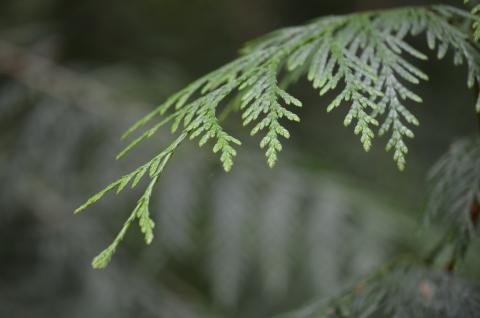Looking for Northern White Cedar

The Tree of Life
The northern white cedar, known as the “tree of life” by 16th century explorers, is one of my favorite trees to see in the woods. The broad, flat, evergreen foliage, along with its unique scent, make for an attractive tree. Though not overly common in Grafton County, it is found in local concentrations and is widespread across New England. It tends to be found in more abundance in the colder areas of the region, such as northern parts of Maine, New Hampshire, and Vermont.
The name “tree of life”, or arborvitae, originated when Native Americans taught French explorer Jacques Cartier how to use the tree's vitamin C-rich foliage to treat scurvy in the mid-1500s. The tree was introduced to Europe for cultivation after that. Tree of life is a suitable name also because of northern white cedar’s ability to live to very old ages, and to stay intact long after it dies. Some live specimens have been found to be over 1,000 years old.
A medium-sized tree, northern white cedar reaches an average height of forty-five feet or so, though on the best sites it may grow taller. Trees typically grow to a diameter at breast height (dbh) of ten to twelve inches, though I’ve seen larger specimens into the twenty inch range, but these are uncommon. A lot of it depends on site conditions, spacing between trees, and the age of the tree.
White cedars are typically associated with “cedar swamps” - those areas characterized by deep, rich, poorly drained soils, where the cedar is often the dominant tree species. Other trees associated with cedar swamps are black spruce and black ash, as well as balsam fir, tamarack, and white spruce. While the northern white cedar often dominates cool, damp soils, it grows best on well-drained, rich upland soils that contain calcium. Sugar maple, white ash, and basswood are more often associated with these sites, but if able to get established, cedar can attain fine form in these areas.
A Tree of Many Uses
Due to its light weight and resistance to rot, northern white cedar is prized for many outdoor uses. Fence posts, rails, shingles, siding, and cabin logs are some of the more common ones. Cedar poles are used in hop yards, holding up the vines (actually called bines) that grow the hops used in beer.
In the days when canoes were fashioned from birch bark or wood and canvas, cedar was used for the canoe ribs and planking. There are still a few builders today who make canoes from these materials. A variation of the birch bark and wood/canvas canoe, the cedar strip canoe shows off the wood by using fiberglass and polyurethane that dries clear, showing the cedar underneath. The planks or strips call for long pieces, which can be difficult to find in white cedar, which tends to be fairly short with the trees tapering rapidly. Western red cedar is now much more commonly used for canoe building due to its availability in longer lengths.
Cedar is also known for its pleasant scent, and is often used in chests for storing blankets, bedding, or clothing. Cedar oil, distilled from the foliage, is used in cleansers, disinfectants, hair preparations, insect repellants, and soaps.
Valued by Wildlife Too
Stands of northern white cedar in low lying areas provide critical deer wintering habitat. The dense crowns of well-stocked mature cedar stands retain snow, reducing the depth underneath, making it easier for deer to travel. Young cedars provide winter browse. White cedar stands also provide habitat for a number of birds, including several species of warbler, sparrows, and woodpeckers.
Northern white cedar can be challenging to regenerate, but can be done in the right circumstances. Cedar can be perpetuated through active management. Cutting strips through the stand or cutting groups or small patches can create conditions for the establishment of new seedlings. If a cedar stand is part of a deer wintering area, it’s important to leave a large percentage of the stand in a densely stocked condition in order to maintain the snow-retention properties. Travel corridors that connect viable cover should be maintained. Because cedar often is found on poorly drained soils, harvesting should be restricted to frozen conditions only.
If you’re fortunate to have northern white cedar on your woodlot, and are interested in learning more about stewardship, contact your County Forester.
Sources:
- Johnston, William F. Northern White-Cedar. Silvics Manual, Volume 1. https://www.na.fs.fed.us/spfo/pubs/silvics_manual/Volume_1/thuja/occidentalis.htm
- Stelmok, Jerry, and Rollin Thurlow. 1987. The Wood and Canvas Canoe: A Complete Guide to its History, Construction, Restoration, and Maintenance. Tilbury House Publishing.


